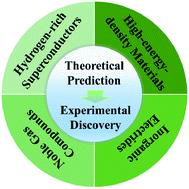Materials by design at high pressures
Abstract
Pressure, a fundamental thermodynamic variable, can generate two essential effects on materials. First, pressure can create new high-pressure phases via modification of the potential energy surface. Second, pressure can produce new compounds with unconventional stoichiometries via modification of the compositional landscape. These new phases or compounds often exhibit exotic physical and chemical properties that are inaccessible at ambient pressure. Recent studies have established a broad scope for developing materials with specific desired properties under high pressure. Crystal structure prediction methods and first-principles calculations can be used to design materials and thus guide subsequent synthesis plans prior to any experimental work. A key example is the recent theory-initiated discovery of the record-breaking high-temperature superhydride superconductors H3S and LaH10 with critical temperatures of 200 K and 260 K, respectively. This work summarizes and discusses recent progress in the theory-oriented discovery of new materials under high pressure, including hydrogen-rich superconductors, high-energy-density materials, inorganic electrides, and noble gas compounds. The discovery of the considered compounds involved substantial theoretical contributions. We address future challenges facing the design of materials at high pressure and provide perspectives on research directions with significant potential for future discoveries.

- This article is part of the themed collection: 2022 Chemical Science Perspective & Review Collection


 Please wait while we load your content...
Please wait while we load your content...